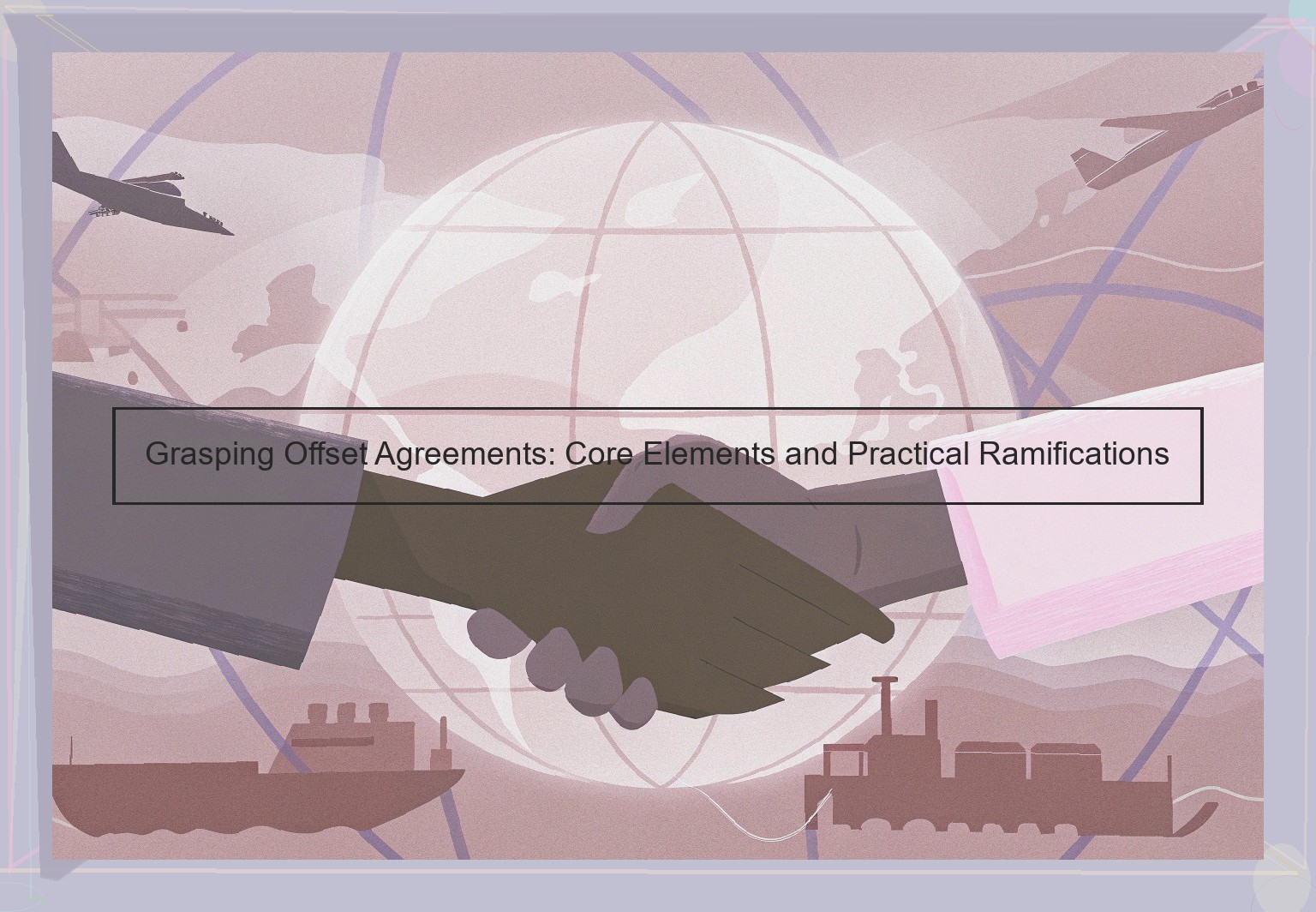Defining the Offset Agreement
An offset agreement is a commercial agreement used in international trade in which a contractor agrees to make certain commercial investments in the importing country as part of the contract. Offset agreements are particularly common when the purchasing customer is a government or other entity that requires the seller to bolster its international industrial base.
The most common type of offset agreement is the economic offset, which is designed to promote international trade . These agreements require the seller to make investments with a particular economic benefit to the importing country, such as exporting goods to or manufacturing them in the purchasing country.
A more specific goal of an offset agreement is the defense-related offset. These agreements require the seller make investments to support the national security objectives of both parties to the agreement. This can involve anything from joint venture cooperation in producing goods and services to licensing intellectual property to one or both of the parties.
Offset Agreement Types
The types of agreements can be categorized in many ways. For example, offset agreements may be classified as direct, indirect, or hybrid.
A direct offset is a commitment by an Offset-related provider to provide tangible items of value to the host government that are directly related to the defense article or service that a foreign government procures from the foreign sale or lease from the U.S. government. Direct offsets are products that are created by the foreign purchaser and used in the final defense product.
An indirect offset is a commitment by an Offset-related provider which is not a direct offset. An indirect offset occurs when tangible items of value are provided to the host government, but not actually incorporated in the final defense product. This includes things such as: industrial know-how, legal services, design and engineering, or site preparation. Indirect offsets do not have a direct tie-in to the purchase or acceptance of defense products.
Hybrids are a combination of direct and indirect offsets. For example, if a foreign purchaser receives an aircraft from a U.S. company, and the supplier then establishes a manufacturing facility in the recipient’s country to produce the aircraft’s wings, that commitment, if approved by the U.S. government, would fall under a hybrid offset. The classification of the agreement depends on whether this commitment was required by the U.S. government.
Legality of Offset Agreements
The legal framework for forward and reverse offset agreements is generally tied to specific contracts that include them and the services being procured with those contracts. Most of the contracts that generate such procurements are entered into between the contractor and national defense departments. Thus, the legal framework for offset agreements is largely determined by international and national defense contracting guidelines.
With respect to international regulations, for certain cases where the United States is party to an international agreement, the United States will seek to formalize its offset agreements with international contractors in a Foreign Military Sales (FMS) Letter of Offer and Acceptance (LOA). Such LOAs formalize the arrangements between the United States Government and the foreign Government receiving defense services. A LOA is subject to terms and conditions of the Arms Export Control Act (AECA), International Traffic in Arms Regulations (ITAR) and Defense Federal Acquisition Regulation Supplement (DFARS). DFARS Section 225.7303 provides contracting officers and agencywide guidance on offsets in FMS sales. Other relevant United States regulations for international offset agreements include the United States Department of State and France Bilateral Agreement on Offsets published by the Department of State in 1985.
With respect to national regulations, the United States Department of Defense has a number of policies that govern the practice of national offsets. For the procurement of defense services, cutoff dates for offset agreements fall on the close of the contract selection announcement date, the date of contract award and the date of contract performance end. After the cutoff date, contracting officers have an affirmative duty to evaluate the costs related to offset agreements as part of the source selection process. In the case of contractor FMS offsets, the National Defense Authorization Act of 1987 and supporting Department of Defense offset enforcement policy stipulates that offsets may be used to adjudicate or mitigate violations of the Foreign Military Sales Act and may be used to satisfy the terms and conditions of an FMS LOA. The Defense Security Cooperation Agency regulates, administers and enforces all offset agreements involving FMS.
Some national governments other than the United States have also established laws, policies and regulations regarding the use of offsets. The commonwealth of Australia has a policy that obligates major military acquisitions involving foreign direct investment to engage in offset agreements that have substantial benefits for the Australian economy. These benefits must focus on restructuring Australian industry or developing advanced technology onshore. Similarly, South Africa has a national policy in which it favors foreign investment that offsets the balance of payments. The North Atlantic Treaty Organization (NATO) has also established a number of guidelines subjecting offset agreements to an offset consideration and review mechanism. Such guidelines require member states to avoid offset measures that provide industrial assistance to one customer in a way that affects competition in the supply of that good to another member state.
Offsets and When to Use Them
Offsets agreements are an integral part of most defence procurement programmes across the globe. Their potential to reduce costs, secure technology transfer and create or safeguard jobs, particularly in the current economic climate, means that their importance is set to increase.
Just like all international trade negotiations, defence procurement contracts are complex, multi-dimensional exercises. Governments cannot unilaterally set the negotiating parameters, nor can defence contractors afford to gamble on a government believing that the contractor will be able to procure the raw materials, parts and services once a tender has been won. Whether the end result is a contract signed by the Government, or in the case of foreign military sales in the US, by the US Government (but which is still subject to offset commitments), offset agreements promise to achieve a better return on investment for the government. They also provide the government with a foothold in the domestic market, which will prove to be of increasing significance as current defence industry networks shift.
For a defence company such as Boeing, offsets make perfect business sense. In particular, the ability to expand access to new markets by securing work that is either unavoidable or indirectly mandatory for an export contract is invaluable. In some cases, it makes more sense to undertake work outside of the US in order to maintain the company’s domestic manufacturing capabilities and to secure future domestic work.
For many countries, the primary motivation for entering into an offset agreement is simply to secure defence contracts at a considerably lower cost. A well implemented offset agreement can spread the investment cost for the procurement project over a longer period of time. Offsets which result in the building of a local supply chain to support the maintenance and life cycle upgrade of a piece of equipment can significantly reduce the associated costs to the procuring government. International defence firms are already benefitting from the US Government’s policy to leverage offset opportunities to support US defence export and industrial base objectives. For example, Boeing cites a $200 million offset package in Brazil which included a 20-year technical assistance agreement to build a sustainable Brazilian supply system for Boeing Commercial Airplanes spare parts and components, as a success story. Such benefits are not limited to those companies who manufacture or produce less sophisticated equipment.
In March 2013, the UK’s Defence Science and Technology Laboratories ("DSTL"), which is the Ministry of Defence’s science and technology research hub, began co-ordinating a £40 million fund to develop laser-hardened electronic systems suitable for use in land vehicles and unmanned aerial vehicle platforms. The DSTL’s co-operation with a US systems manufacturer resulted in the adoption of a modified component with a much longer lifetime in a helicopter programme with which the Ministry of Defence already works. The Ministry has now ordered components for six of its platforms and there is scope to adopt this technology on other platforms.
Reviewing and agreeing to whether an offset agreement should be agreed is a real opportunity to achieve a win-win situation for both government and contractor. This must, however, be carefully managed.
Offset Agreements’ Economic Significance
While often contained in legally binding contracts, offset agreements do not usually find their expression in treaty form. However, the economic and commercial implications of such agreements on the global economy as well as on national economies are significant. The main area of impact is on the balance of trade due to positive impacts including trade deficits, incentives for establishing local supplies and manufacturing, foreign direct investments, technology transfer and employment opportunities. The common adverse impact is on national domestic industries caused by competition from protective or preferential partners. However, offset agreements can also create a unique opportunity to establish real employment in the defense industry sectors of the countries of the contract.
Many countries, due to their limited size and labor pool, have to rely on their citizens against a substantial proportion of future procurement targets. In contrast, many of the large defense contractors such as BAE Systems and Northrop Grumman are located in countries with large populations. For many military procurement programs , large defense contractors can only go to small niche operators to fulfill their biddable requirements. However, in many developing countries, most of the industrial supply is already associated with military requirements. Therefore both small-scale and large-scale defense companies must be ready to make the necessary trade-offs to have their needs and requirements satisfied. To make their production competitively viable these companies, through their parent companies, need to have consistent access to export markets that will provide them with a steady flow of projects and work. As long as the overseas program requirements are fulfilled, the foreign company can compete for local work. For developing countries with limited financial resources, FDI is often the only way to acquire advanced technologies, the means of production and sufficient resources to be able to take advantage of the offsets. In such cases the foreign partner must provide all the necessary resources to produce the selected items. The FDI not only provides funding for them to enter the market but also allows the local companies to join supply chains, thereby avoiding the risks of overcapacity.
Dissent and Objections Regarding Offsets
Despite their advantages, offset agreements have come under criticism. Critics argue that they are overly complex and, therefore, often lack transparency. One practical consequence that can flow from a transparent process is an increase in compliance costs. These higher compliance costs can be disruptive to the marketing of goods or services.
With regard to complexity, the elements of an offset agreement can vary wildly, depending upon the country. Even when two countries appear to have similar concepts of offset, they may differ in the details. Further, each element of the offset needs to be tailored to the particular deal. This can make aggregating all the elements somewhat of a headache – so much so that some contractors choose to ignore the problem altogether. Although it may be tempting to cut corners, failing to properly document or identify offset agreements at the outset can lead to significant compliance shortcomings down the road: non-compliance with an offset agreement can result in penalties and sanctions up to and including the retraction of a contract award.
Offset agreements are controversial whenever the receiving country has geopolitical considerations. In the Gulf region, for example, the Arab Spring has left it vulnerable to unrest, and it is not difficult to see how an offset agreement could become a target. Some groups will object to an agreement on its face, and lobbying efforts can become intense. This does not mean that contracting parties are ready to abandon offset in deference to protests or lobbying, but countries considering more onerous offset provisions should be mindful of the potential fallout.
Outlook for Offsets
Looking forward, offset agreements are likely to undergo significant changes as a result of several trends. First, the trend towards greater public access to information will affect offset transactions globally, not only in the U.S. but also in Europe and elsewhere. Legislating transparency in offset transactions will continue to be a priority for the federal government. The new Countering America’s Adversaries Through Sanctions Act requires the Director of the Office of Management and Budget, after consultation with the Secretary of Defense, the Secretary of State, and the Secretary of Commerce, to submit to Congress a report that describes actions to enhance the transparency of offset agreements. The report must include "a list of the persons in the [United States] who work in or on connection with foreign military sales offset arrangements"; a description of the actions taken to provide transparency to offset process participants; and the countries that do not disclose pertinent information on offset arrangements . In European Union member countries, the database of offset agreements will continue to grow. Second, governments are increasingly emphasizing the protection of information. In some countries such as South Korea, any confidential information in an offset agreement is now required to be marked as such. Governments expect that sensitive information in offset agreements will be safeguarded through secure handling and storage, and the disclosure of this information is strictly limited to only those persons authorized to possess it. Within the last year, several recent news reports have emphasized the need to safeguard sensitive information, and we expect to see more such articles address the importance of protecting confidential information. In particular, we expect that Offset Managers will highlight the need to protect such information among offset stakeholders within their jurisdictions.



